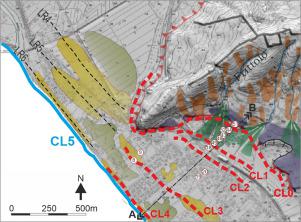Geomorphology ( IF 3.1 ) Pub Date : 2021-03-11 , DOI: 10.1016/j.geomorph.2021.107694 Vincenzo Amato , Luigi Cicala , Ettore Valente , Maria Rosaria Ruello , Nunzia Esposito , Elda Russo Ermolli

|
Coastal areas are very dynamic environments where natural and man-induced modifications often interact. This is the case of the Graeco-Roman town of Elea-Velia, along the Cilento coast of southern Italy. The town was founded in the 6th century BCE on a hilly promontory bounded by two profound gulfs and assumed a prominent role in maritime commercial routes in the Graeco-Roman period. It declined in the Late Antiquity and was abandoned in the Middle Ages also due to serious landscape changes. In this study, the integration of geomorphology, borehole stratigraphy and analysis of archaeo-stratigraphical trenches was used to detail the relationship between geological and archaeological evidence. The huge amount of collected data allowed providing chronological constraints to the landscape modification occurred before and after the town foundation. The main environmental changes consisted in enhanced coastal progradation and alluvial fan deposition that mainly affected the lower quarters of the town. The results of this study suggest that alluvial flooding was one of the main causes of the Elea-Velia decline and subsequent abandonment. The increasing disruption of slope stability was driven by the neglect in the management of the hillslopes behind the town during periods of social-economic crisis, but a concomitant climate forcing cannot be excluded. To the final abandonment also contributed the declining of harbour activities and the consequent decreased relevance of Elea-Velia as a maritime centre.
中文翻译:

地中海沿岸人为地貌过程的人为放大:来自希腊罗马古镇埃里亚-维利亚(意大利坎帕尼亚)的案例研究
沿海地区是非常动态的环境,自然和人为因素往往会相互作用。意大利南部奇伦托(Cilento)沿岸的古希腊罗马小镇埃莱亚(Elea-Velia)就是这种情况。该镇始建于公元前6世纪,位于丘陵海角上,由两个深深的海湾包围,在古罗马时期的海上商业路线中发挥了重要作用。它在上古时代已衰落,在中世纪也由于严重的景观变化而被废弃。在这项研究中,地貌学,钻孔地层学和考古地层沟的分析的综合被用来详细说明地质和考古证据之间的关系。所收集的大量数据为按时间顺序排列的景观修改提供了条件,这些条件发生在城镇地基之前和之后。主要的环境变化包括沿海沿海地区的退化和冲积扇沉积的增加,这主要影响了该镇的较低地区。这项研究的结果表明,冲积洪水是Elea-Velia下降和随后被遗弃的主要原因之一。在社会经济危机时期,由于忽视了小镇后面的山坡,导致对边坡稳定性的破坏日益加剧,但是不能排除随之而来的气候强迫。最终的遗弃还导致港口活动的减少,以及随之而来的埃里亚-韦利亚作为海事中心的相关性下降。这项研究的结果表明,冲积洪水是Elea-Velia下降和随后被遗弃的主要原因之一。在社会经济危机时期,由于忽视了小镇后面的山坡,导致对边坡稳定性的破坏日益加剧,但是不能排除随之而来的气候强迫。最终的遗弃还导致港口活动的减少,以及随之而来的埃里亚-韦利亚作为海事中心的相关性下降。这项研究的结果表明,冲积洪水是Elea-Velia下降和随后被遗弃的主要原因之一。在社会经济危机时期,由于忽视了小镇后面的山坡,导致对边坡稳定性的破坏日益加剧,但是不能排除随之而来的气候强迫。最终的遗弃还导致港口活动的减少,以及随之而来的埃里亚-韦利亚作为海事中心的相关性下降。









































 京公网安备 11010802027423号
京公网安备 11010802027423号